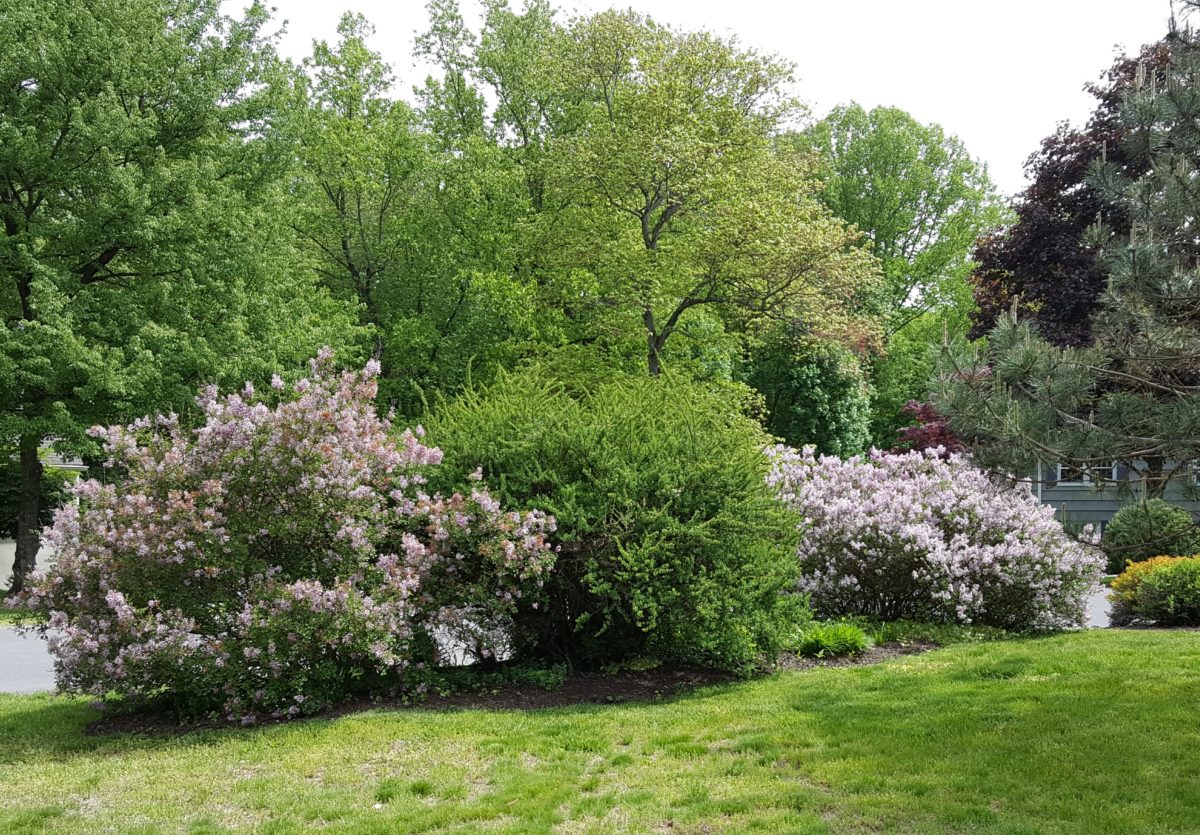List of deer resistant shrubs
Shrubs are woody plants that can grow many years. Some shed their leaves in autumn, while others are evergreen. When you select a shrub, you need to consider its hardiness and resistance to deer. In addition, you should also consider its mature height and width and preference of sun/shade exposure for a particular site. Here is a list of recommended deer resistant shrubs for the Northeast region. Many of them are available from online stores such as jungseed.com. They grow happily in my garden without severe damage by deer.
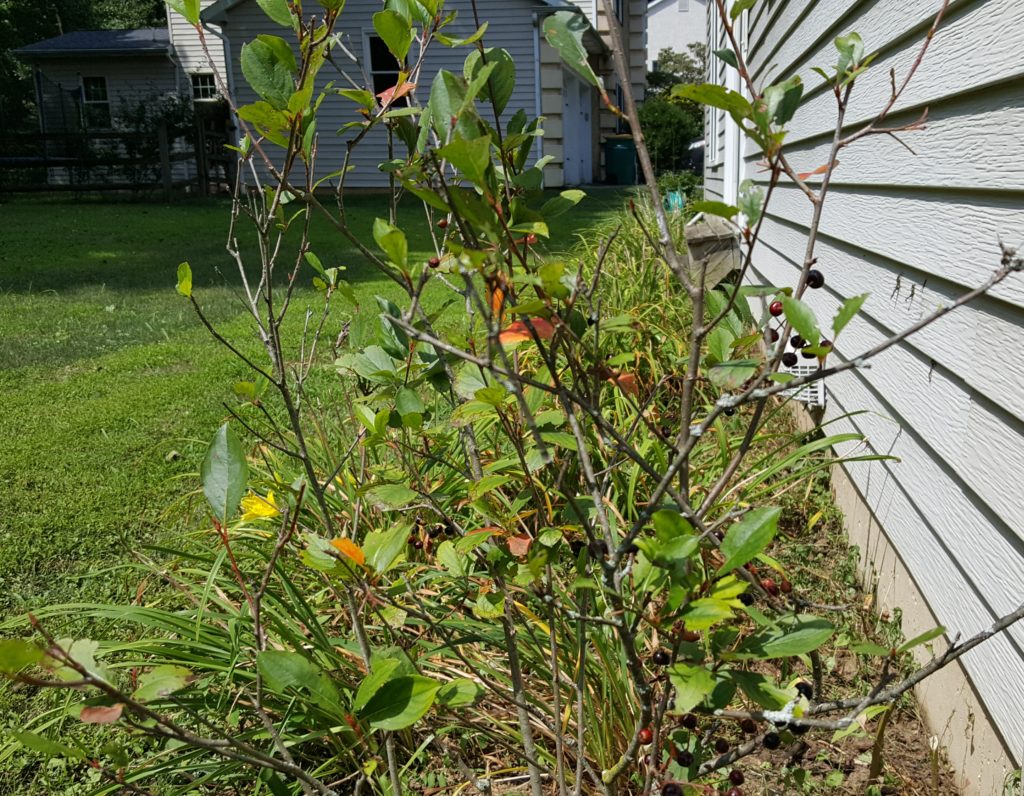
Aronia melanocarpa (Black chokeberry). Zones 3-8, full sun to part shade, 3-6 ft tall and wide. This upright deciduous shrub tolerates wet soil. It produces clusters of white flowers in May and black berries in autumn. Leaves turn purple/red in fall, but they are not spectacular like burning bush. It is a better landscape shrub than its taller cousin, Red chokeberry. Both are deer resistant.
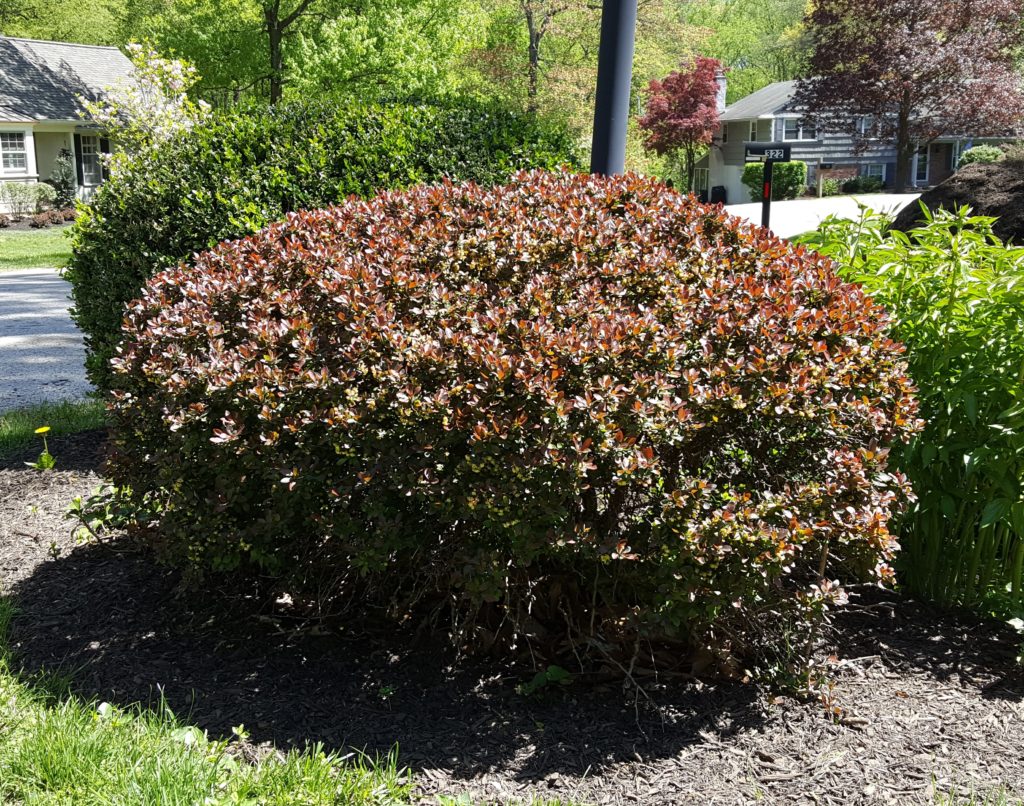
Berberis thunbergii (Japanese barberry). Zones 4-9, full sun, 3-5 ft tall and 3 ft wide. This beautiful deciduous shrub has small red leaves on thorny twigs, adding contrasting color to the other green shrubs. It has tiny red berries in fall. Because of its thorns, deer will leave it alone. It is care-free, just need light shearing in spring to keep it in shape. Its leaves will turn green when shaded by other shrubs.
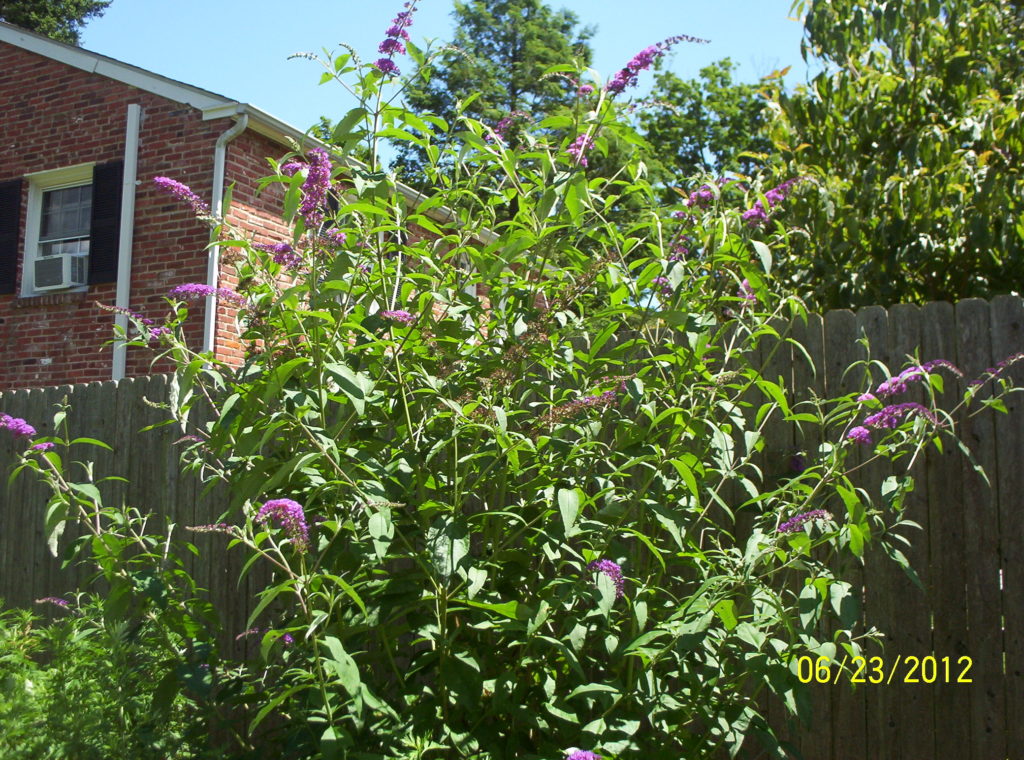
Buddleja davidii (Butterfly bush). Zones 5-9, full sun, 6-7 ft tall. It is a magnet for butterflies with its spikes of pink, purple or white flowers on new wood from mid-summer to late summer. Butterfly bush is care-free, simply cut the stems back to 12 inches in early spring. Deer never bother them. There is also a dwarf variety that grows to only 32 inches tall. It will be good for small space.
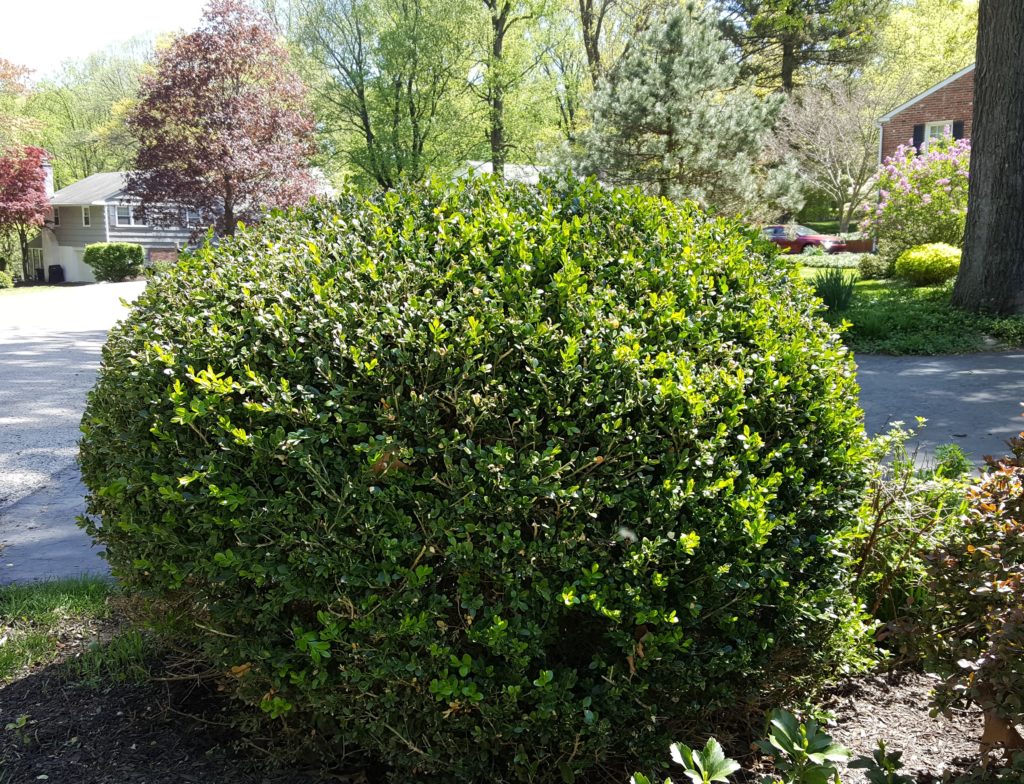
Buxus microphylla koreana (Korean Littleleaf Boxwood). Zones 5-9, full to part sun, 2 ft tall and 3 ft wide. This evergreen shrub is a favorite in any landscape. It can be used a single specimen or in a row as a short hedge. It has small shiny leaves that deer tend to avoid. Boxwood is carefree, just need light shearing to maintain a round shape in spring. There are many other dwarf boxwoods, some are not as cold hardy and part of their leaves may turn brown in winter. So select the shrub with hardiness of zone 5 or below.
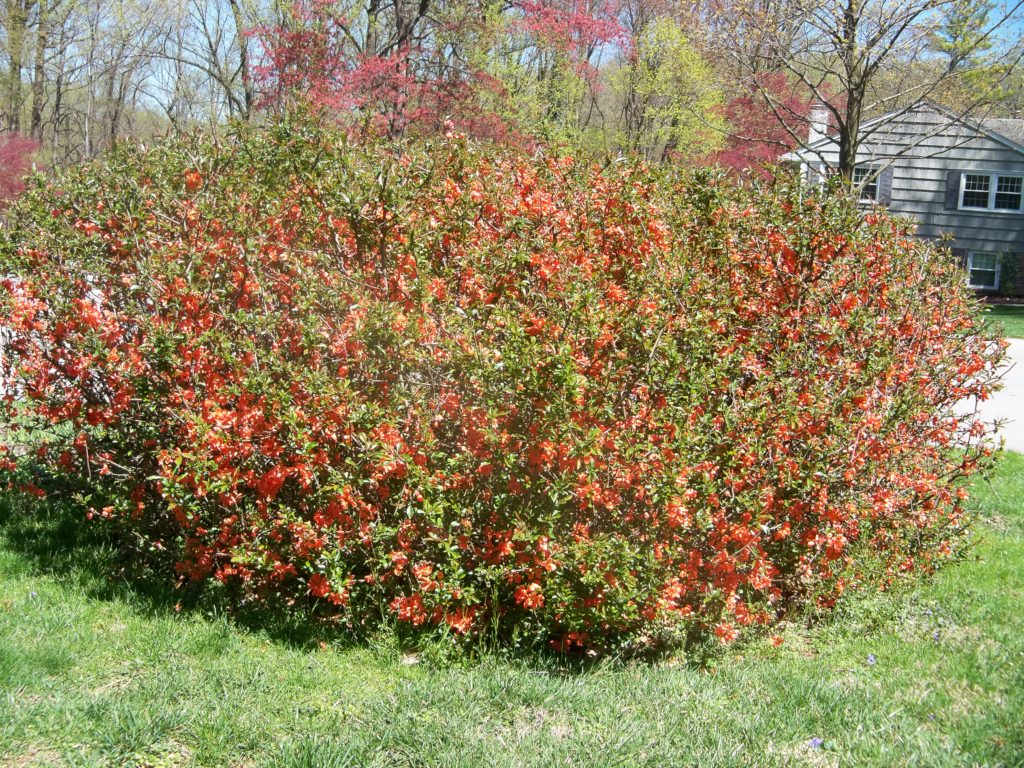
Chaenomeles speciosa (Flowering Qunice). Zones 5-9, full sun to part shade, 4-6 ft tall. This multi-stem shrub produces red, orange, white or pink flowers in early spring (about the same time as forsythia) and pear-like fruits in summer. However, the fruits, though edible, are very tart. They are good for making jams and jelly. It needs some shearing to maintain its shape. Deer do not bother them.
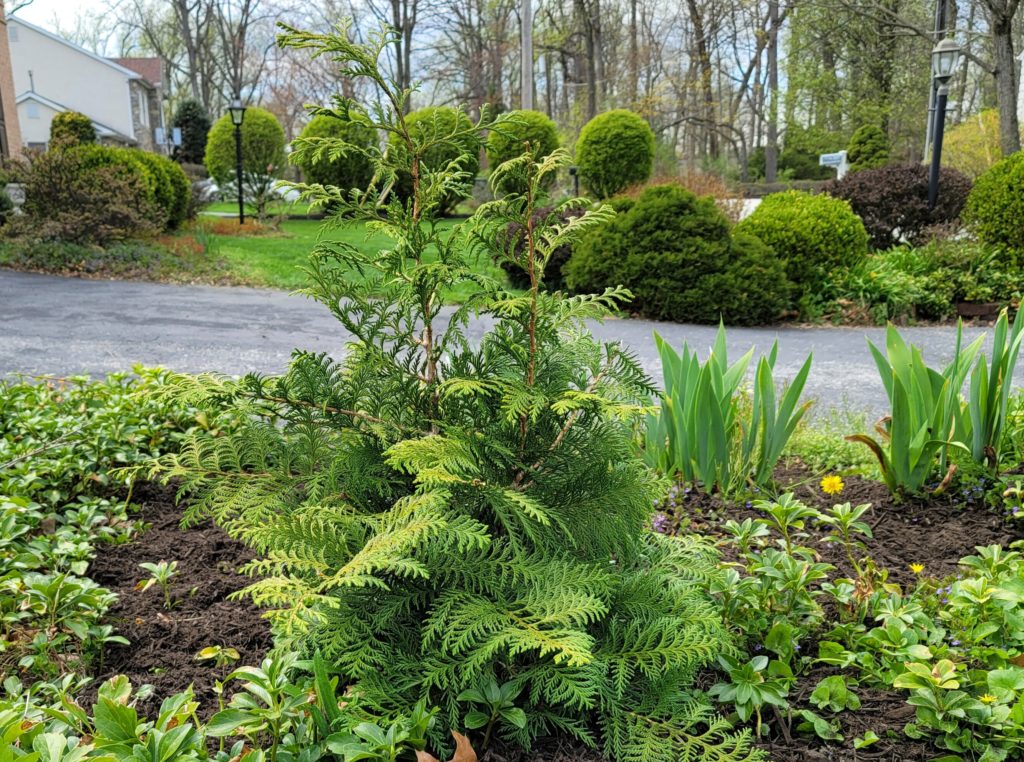
Chamaecyparis pisifera ‘Dow Whiting’ (Soft Serve False Cypress). Zones 4-8, full to part sun, 6-10 ft tall and 5-6 ft wide. This handsome medium-sized evergreen shrub with soft, fern-like foliage is a must-have for every landscape. You can use it as a specimen or in a row as a low maintenance hedge. It tolerates salt, resists deer, and requires little pruning.
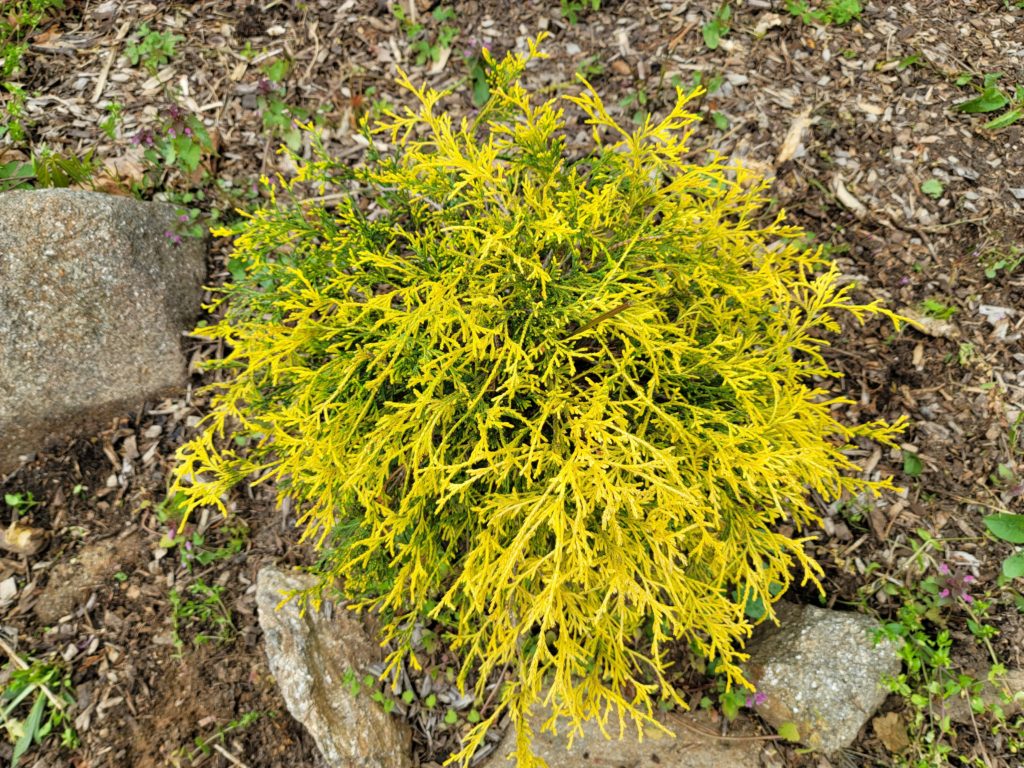
Chamaecyparis pisifera filifera aurea (False Cypress King’s Gold). Zones 4-8, full to part sun, 3-4 ft tall and wide. This slow growing evergreen has golden yellow leaves that turn to lime green as they age, adding contrasting color to other green shrubs. It is great for rock gardens and slopes. No pruning is required. Deer do not bother them. It is an alternative to gold tip juniper.
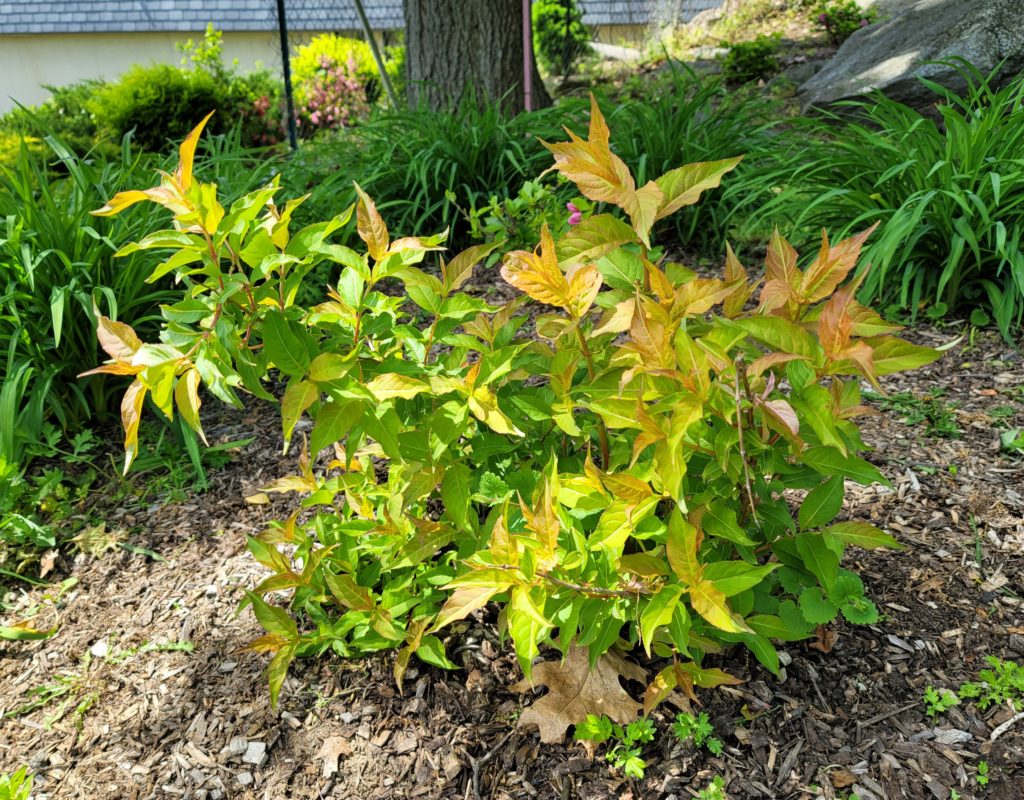
Diervilla ionicera (Kodiak Orange). Zones 4-7, full sun to full shade, 3-4 ft tall and wide. This bush Honeysukle has lush green foliage with orange new growth. It produces yellow flowers in early summer. In fall, the green leaves turn to orange-red that is comparable to Burning Bush. It is drought-tolerant. Deer may eat their leaves, but seldom severely damage the shrub.
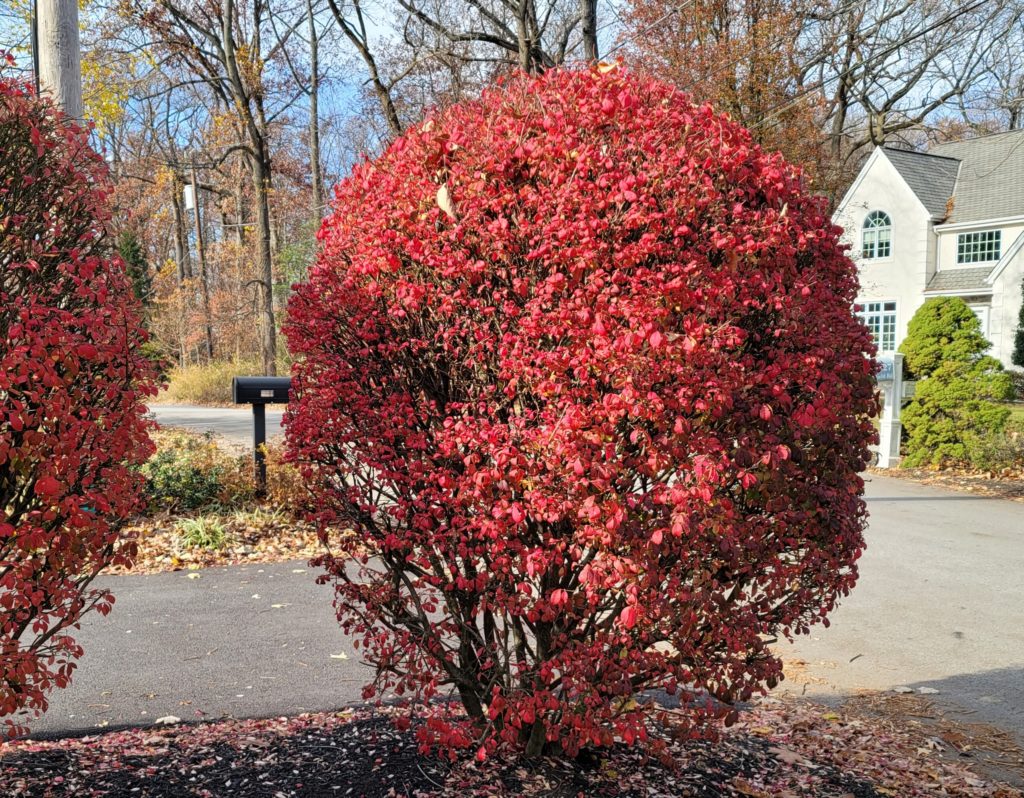
Euonymus alatus (Burning Bush). Zones 4-8, full sun – partial shade, 4 – 8 ft tall depending on variety. This multi-stemmed, rounded deciduous shrub is famous for its brilliant red fall foliage. It is of low maintenance, no pruning is required. However, some people like to trim it into a round shape. Deer may eat the young leaves in early spring, but seldom severely damage the shrub.
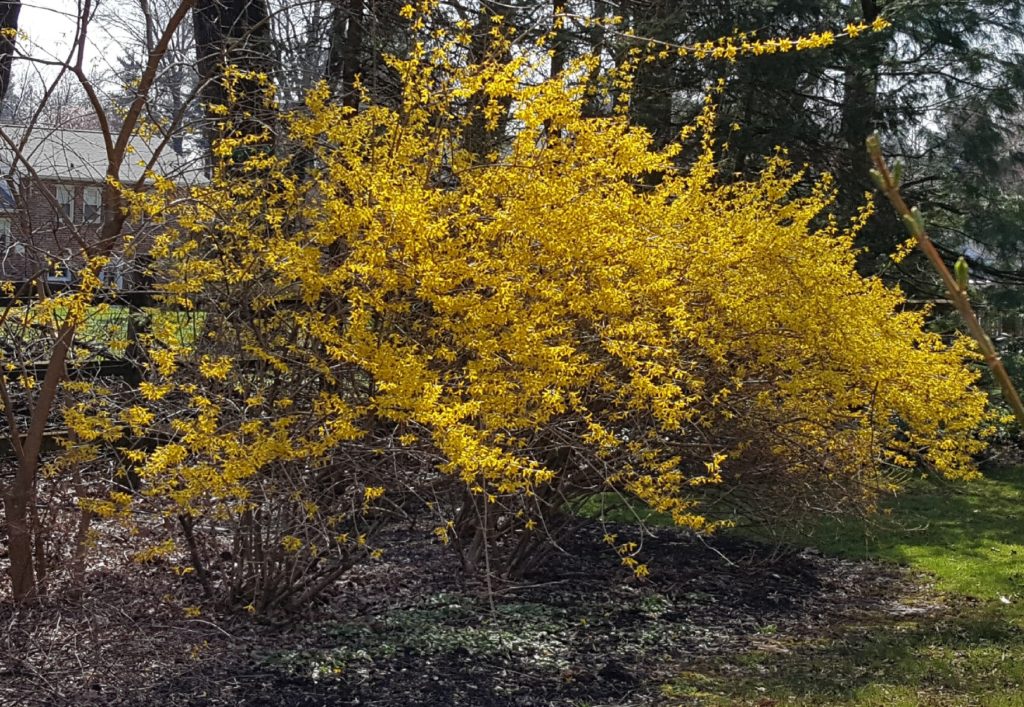
Forsythia suspensa (Weeping forsythia). Zones 5-8, full sun to part shade, 6-10 ft tall and wide. This upright, arching deciduous shrub is famous for being the first shrub that blooms in spring. Their profuse yellow flowers appear before leaves. It is resistant to deer and black walnut toxin. Some people like to trim it into a round shape. If left alone, the weeping branches will root where they touch ground, forming daughter shrubs.
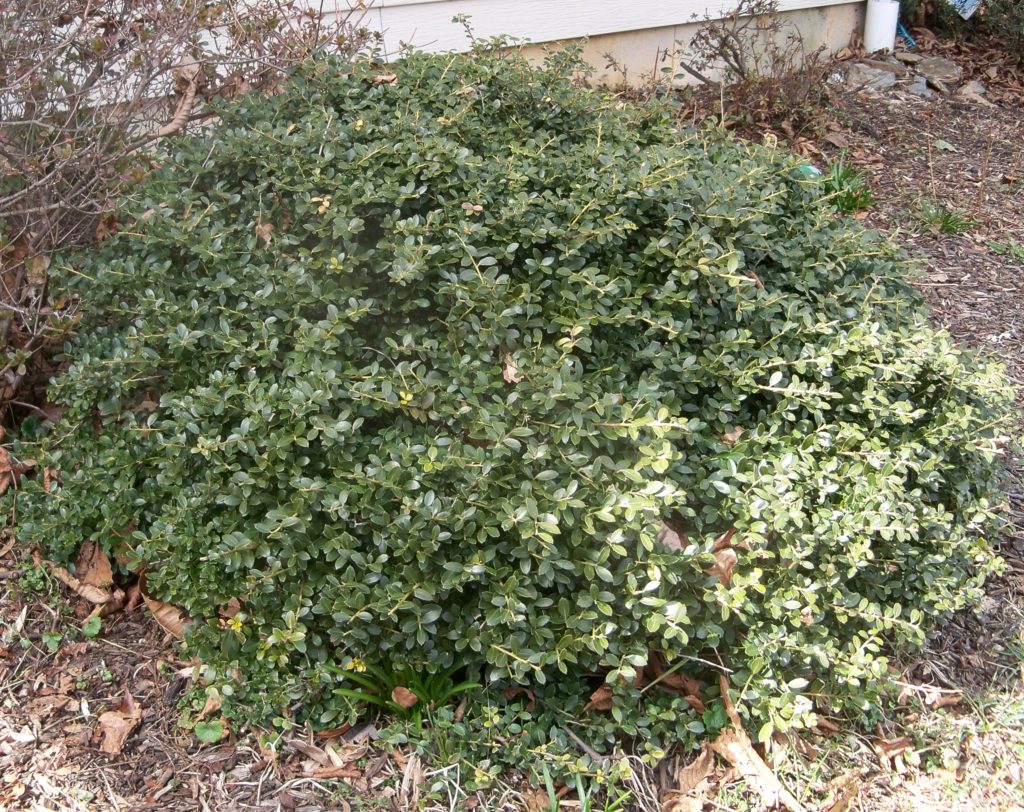
Ilex crenata (Dwarf Japanese Holly). Zones 6-9, part to full shade, 1 ft tall and 2 ft wide. This little evergreen gem looks like a boxwood, with small shiny leaves. Although it is not listed as a deer resistant shrub, deer never bother it in my garden. It is care-free, just needs a light shearing to maintain its shape.
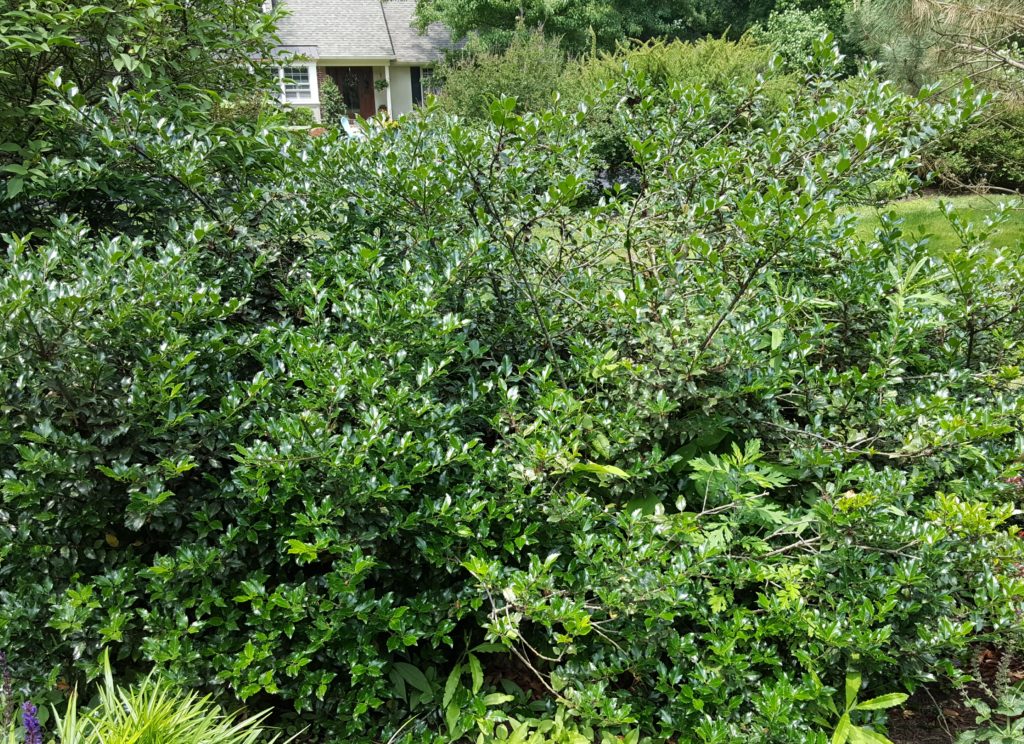
Ilex meserveae (Blue Holly). Zones 5-9, full sun to part shade, 6-7 ft tall and wide. This medium size evergreen shrub has dark blue-green glossy leaves and red berries on female plants. It needs a male plant in the vicinity as pollinator for production of berries. Although it is not listed as a deer-resistant shrub, deer rarely damage it in my garden. It is carefree, and needs just a light pruning.
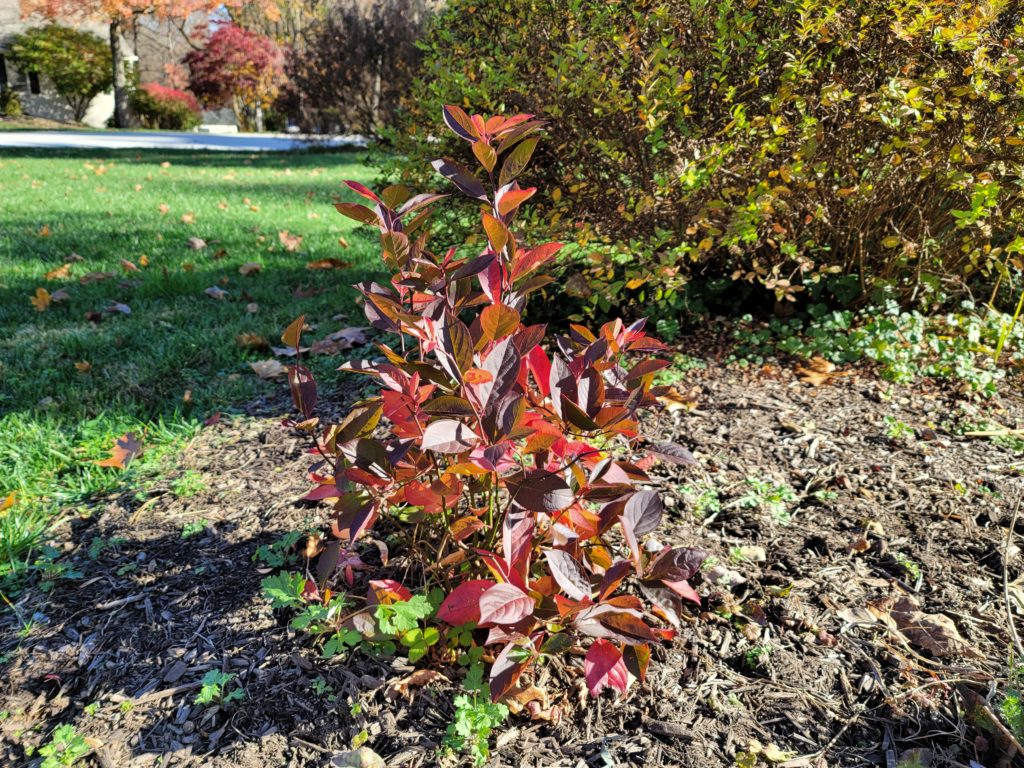
Itea virginica (Little Henry Sweetspire). Zones 5-9, full sun to full shade, 2-3 ft tall and wide. This native deer resistant shrub requires little maintenance. In early summer, it produces sweetly scented, long white flowers. In fall, the green foliage will turn to multiple shades of orange and red. It can stand wet soil and is also drought resistant.
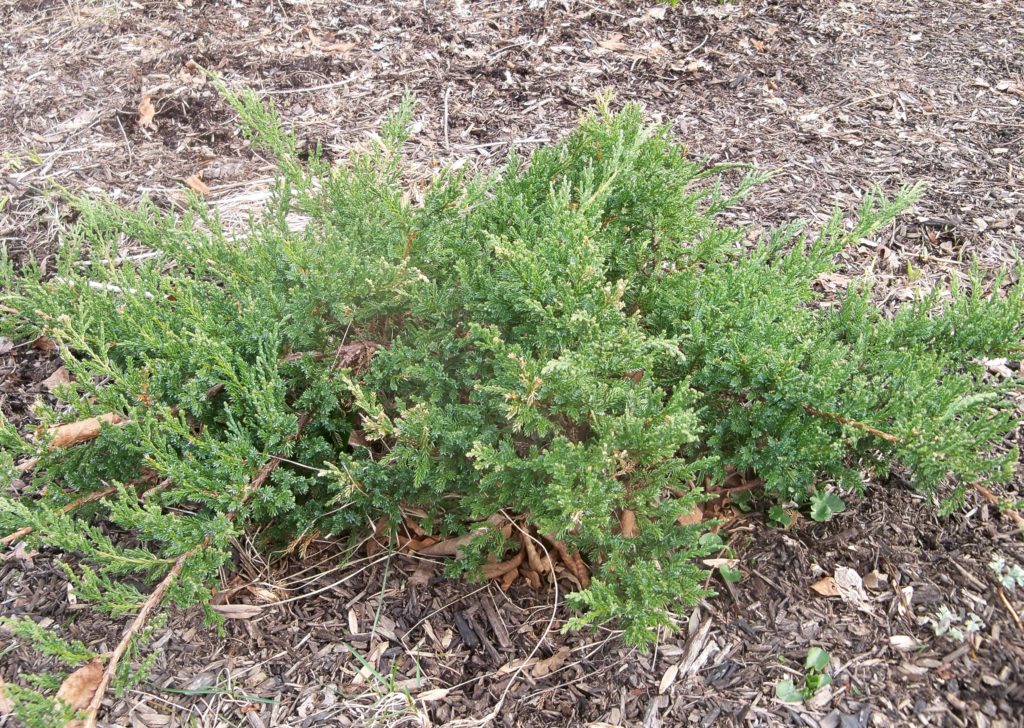
Juniperus chinensis var. sargentii (Sargent Juniper). Zones 4-10, full sun, 1-1.5 ft tall and 4 ft wide. Junipers are good evergreen shrubs for all landscapes. They have fine-textured, light-blue-green leaves. Furthermore, they are care-free and deer-resistant. There are other varieties of junipers with various height and spread, so read the label carefully before purchase.
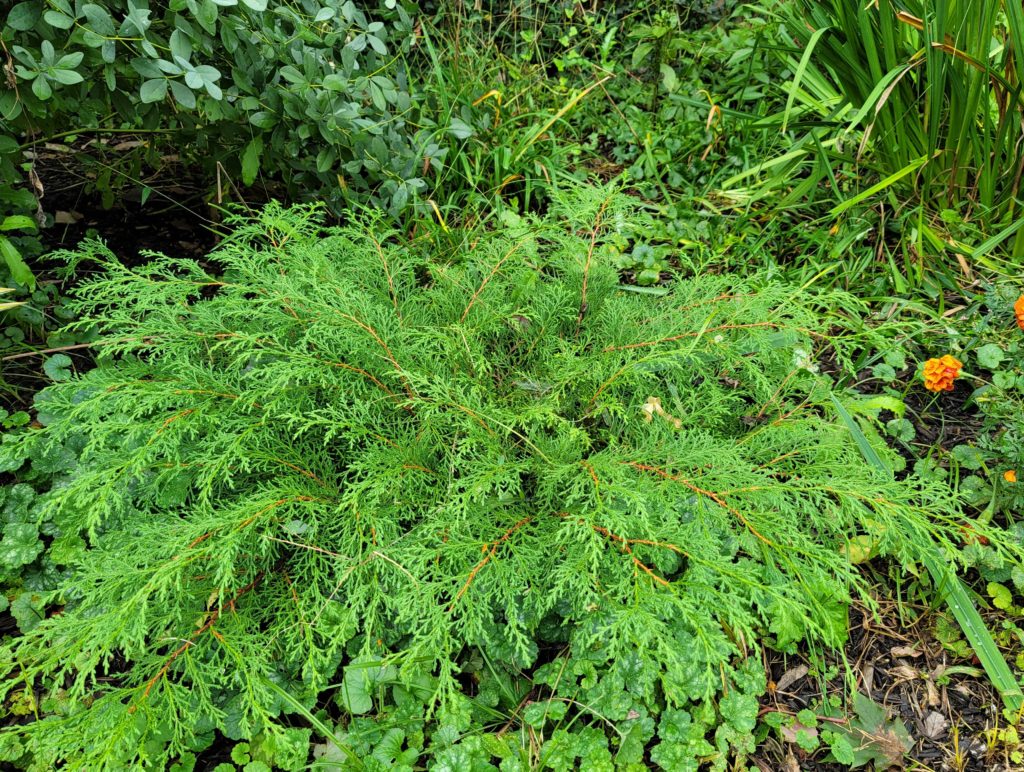
Microbiota decussata (Siberian Carpet Cypress “Fuzzball”). Zones 3-8, 12-24 inches tall and 36 inches wide, full-sun to part-shade. This dwarf evergreen conifer is good for a low-maintenance ground cover. Its bright green foliage turns bronzy-purple in winter. It is an alternative to dwarf juniper for part shady area, because it tolerates shade. Deer do not bother it.
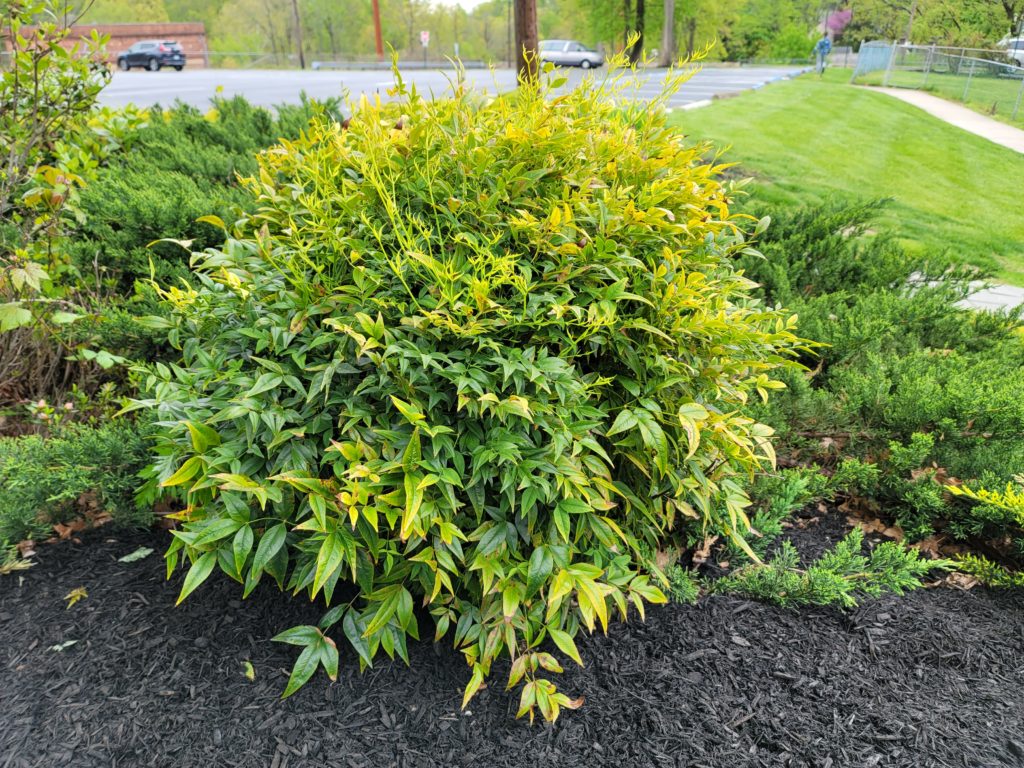
Nandina domestica (Heavenly Bamboo). Zonez 6-9, full sun to partial shade, 7 ft tall and 5 ft wide. This broad leaf evergreen shrub is not related to bamboo at all. It is so named because it has cane-like stems and finely textured leaves like those of bamboo. It grows slowly and is deer resistant. The color of its leaves changes from bronze to green to red as season changes. This beautiful shrub is care-free once established.
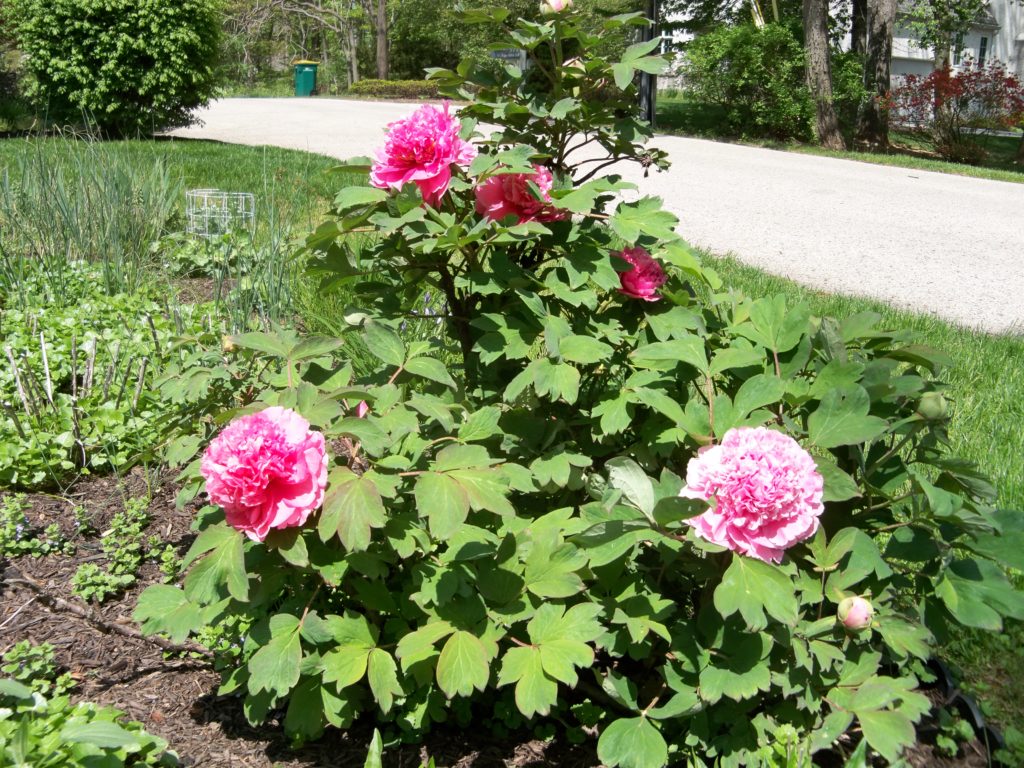
Paeonia suffruticosa (Tree Peony). Zones 3-9, full sun to part shade, 6 ft tall and wide. Unlike its herbaceous cousin, this slow-growing deciduous shrub has woody stems that survive the winter. Do not cut off the stems in fall as you do for the herbaceous peonies. New flower and leaf buds will appear on the woody stems early in spring. It is a long-lived shrub, producing huge flowers with various colors year after year, depending on cultivars. Deer do not bother it.
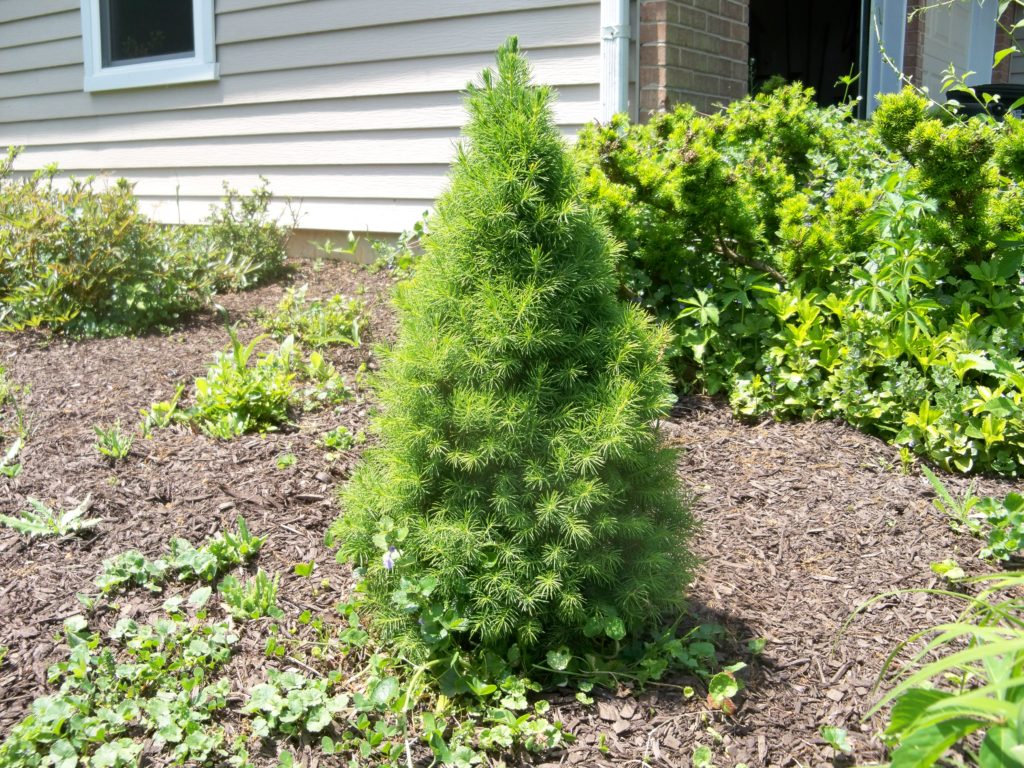
Picea glauca ‘Conica’ (Dwarf Alberta Spruce). Zones 3-8, full sun to part shade, 8 feet tall and 5 feet wide. This slow growing cone-shaped conifer is perfect for the north-eastern corner of the foundation, as it needs protection from harsh winter sun. It has soft light green needles and looks like a miniature Christmas tree. Maintenance is minimal. Deer do not bother it.
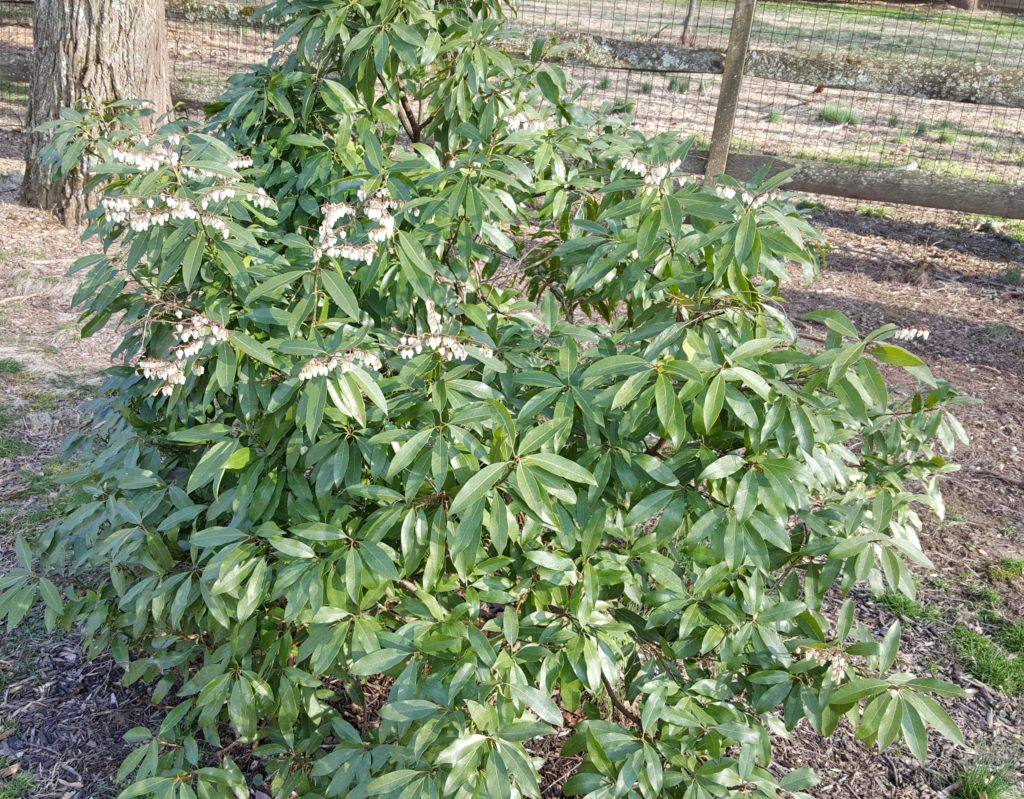
Pieris japonica (Japanese andromeda). Zones 6-9, full shade, 6-8 ft tall and 5 ft wide. This evergreen broad leaf shrub is perfect for a shady area. It has dark-green leaves and drooping panicles of tiny white flowers in spring. Pieris is truly deer-resistant and carefree. However, it is very sensitive to black walnut toxin. Do not plant this shrub, if there is a black walnut tree nearby. It is also sensitive to Norway maple.
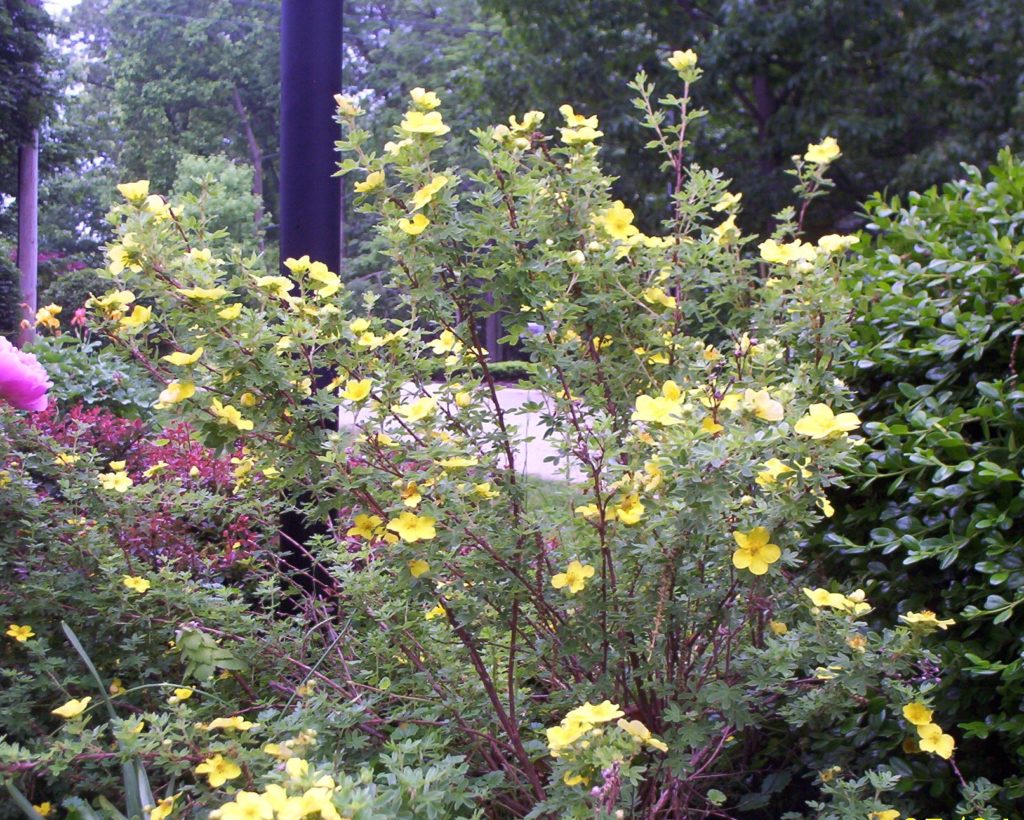
Potentilla fruticosa (Cinquefoil). Zones 3-9, full sun, 2-3 ft tall and wide. This deciduous shrub has small fern-like leaves and tiny yellow flowers all summer. It tolerates dryness. You can clip off the top half to prevent it become leggy. Care is minimal, you just need to prune off some dead branches in spring. Deer leave it alone.
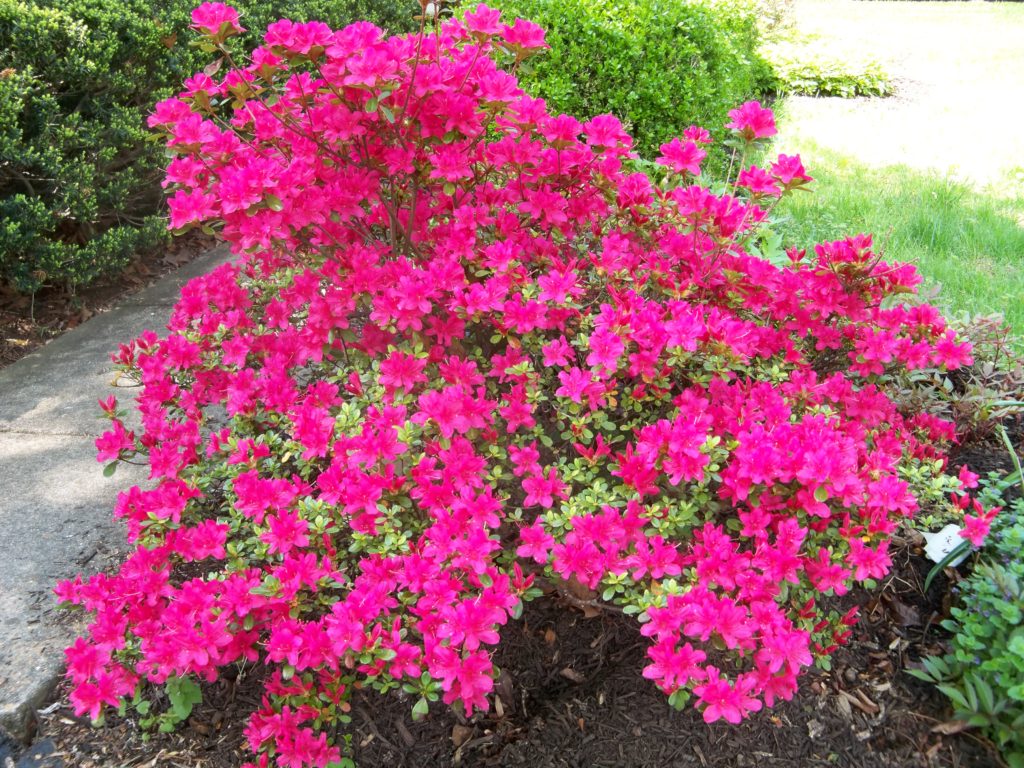
Rhododendron varieties (azalea and rhododendron). Azalea and rhododendron are perfect shrubs for semi-shady locations, although some tolerate full sun. Both require well-drained, acidic soil. Addition of acidifying fertilizer and elemental sulfur helps keep soil acidic. They have different height, flower color and cold hardiness. So read the label carefully before purchase. Although these shrubs are poisonous, deer will eat their leaves and flower buds during wintertime when food is scarce. The leaves will grow back in spring, but the number of flowers will greatly diminish as a result.
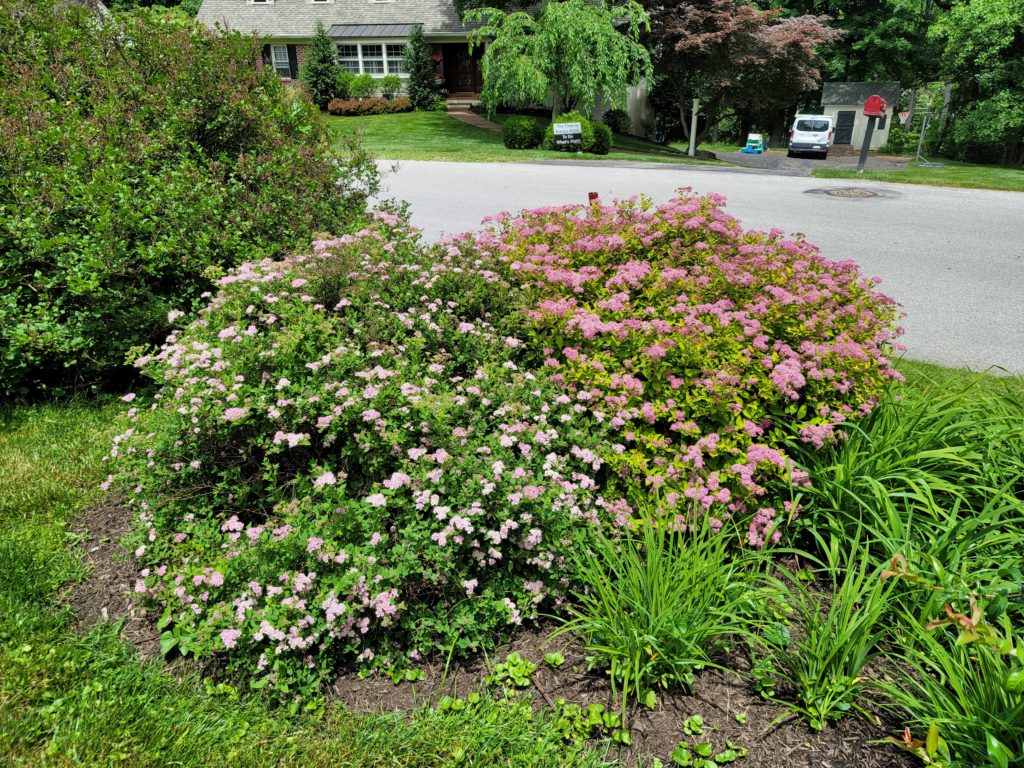
Spiraea japonica (Japanese spirea). Zones 3-8, full sun, 2-3 ft tall and wide. These lovely deciduous shrubs have different leaf and flower colors, depending on variety. Shown in the picture above are “Little Princess” (left) and “Magic Carpet” (right). They bloom in early spring. Shearing spent flowers encourages reblooming. Deer may eat young plants to the ground, so protect them with wire fence in the first year. Once they are established, deer will not bother them. They are care-free; just need a light shearing in early spring to maintain the round shape.
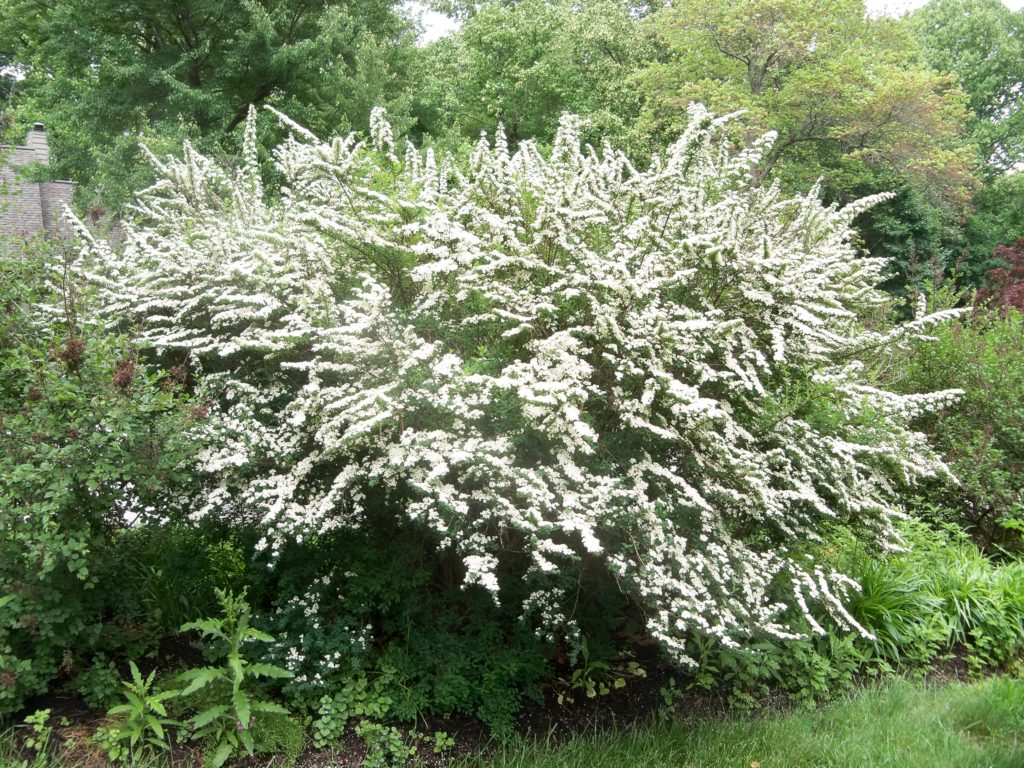
Spiraea nipponica ‘Snowmound’. Zone 3-8, full sun to part shade, 3-5 ft tall and wide. This is a dense, upright, vase-shaped deciduous shrub with white flowers in May to June. It is similar to Spiraea vanhouttei, but in a neater shape and smaller. It is carefree, shearing is not necessary. Deer will not bother it.
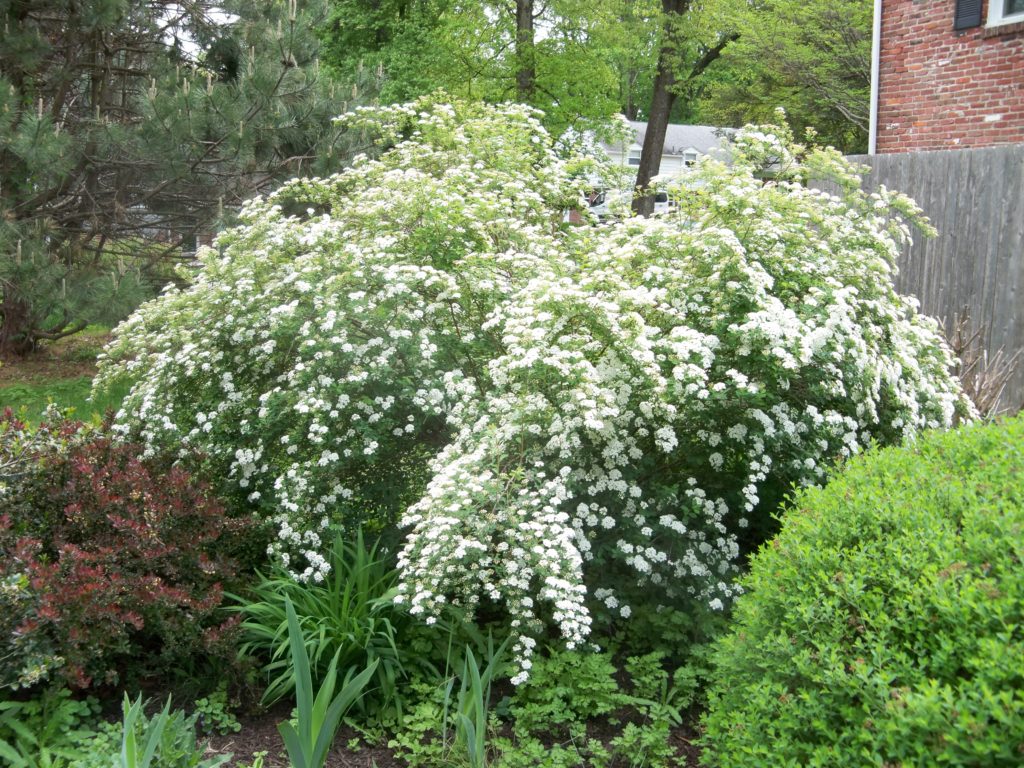
Spiraea vanhouttei (Vanhoutte Spirea, Bridal Wreath). Zones 3-7, full sun, 6-8 ft tall and 6 ft wide. This graceful deciduous shrub has blue-green, toothed leaves on arching branches. It produces clusters of white flowers in June. It is care-free, and deer leave it alone. Shearing is not necessary.
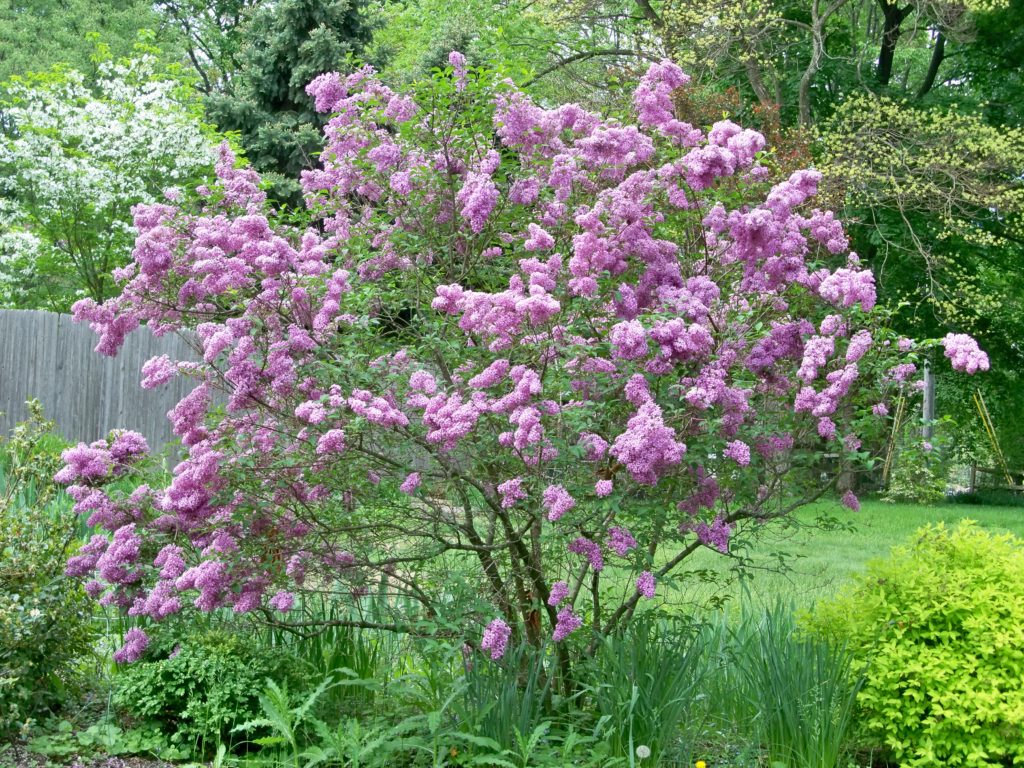
Syringa x persica (Persian Lilac). Zones 3-8, full sun, 8-12 ft tall and 8 ft wide. This deciduous shrub is famous for its beautiful flowers and fragrance. It has large heart-shape, blue-green leaves and showy clusters of fragrant light purple flowers in late spring. Furthermore, it is deer-tolerant, and is carefree. It just needs light pruning of dead branches.
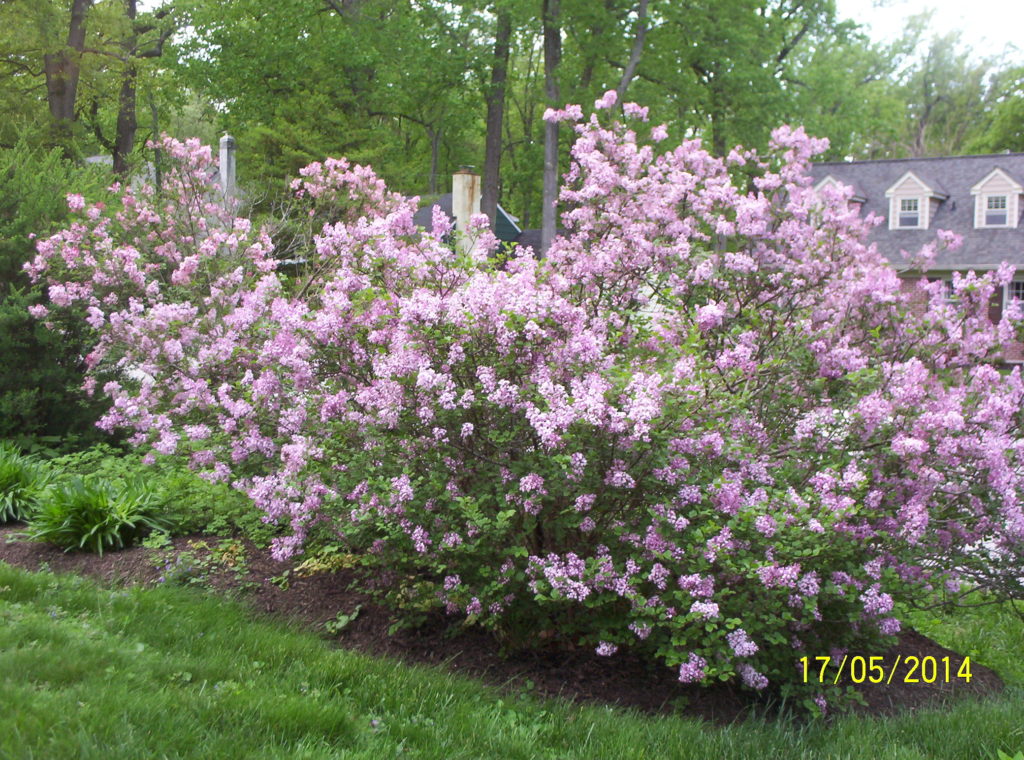
Syringa meyeri (Korean Lilac). Zones 3-7, full sun, 4-5 ft tall and 5-7 ft wide. This dwarf lilac is my favorite. It produces showy clusters of fragrant light lilac flowers in May-June. It does not need pruning, but you may need to keep suckers in check. There are many other dwarf lilacs with various flower colors. One type is called Boomerang Lilac, because it blooms in spring and then reblooms in late summer. All lilacs are deer resistant.
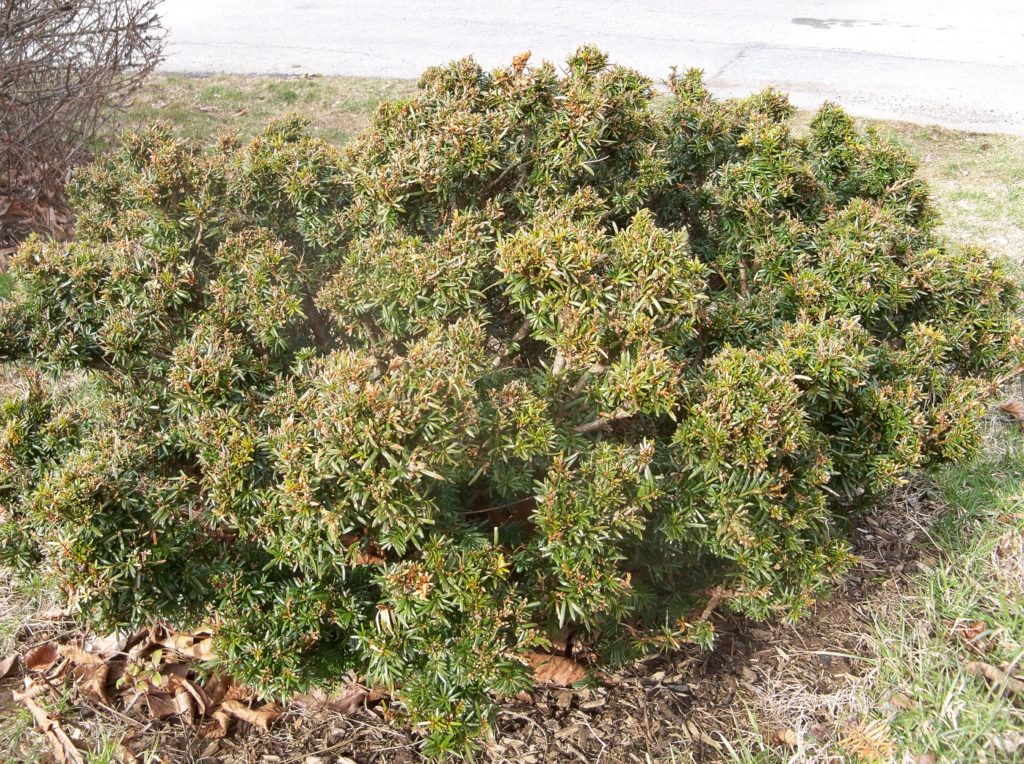
Taxus cuspidata (Japanese Yew). Zones 4-8, part to full shade, 3-4 ft tall and wide. This evergreen shrub with dark-green needle-like leaves is perfect for the shady side of foundation. However, it can also stand full sun. Japanese Yew can be used as a single specimen or in a group as hedge. It is not listed as deer-resistant, even though its leaves are poisonous. However, deer seldom damage established shrub severely. It is care-free, just needs a light shearing every year to maintain the shape. They grow very slowly.
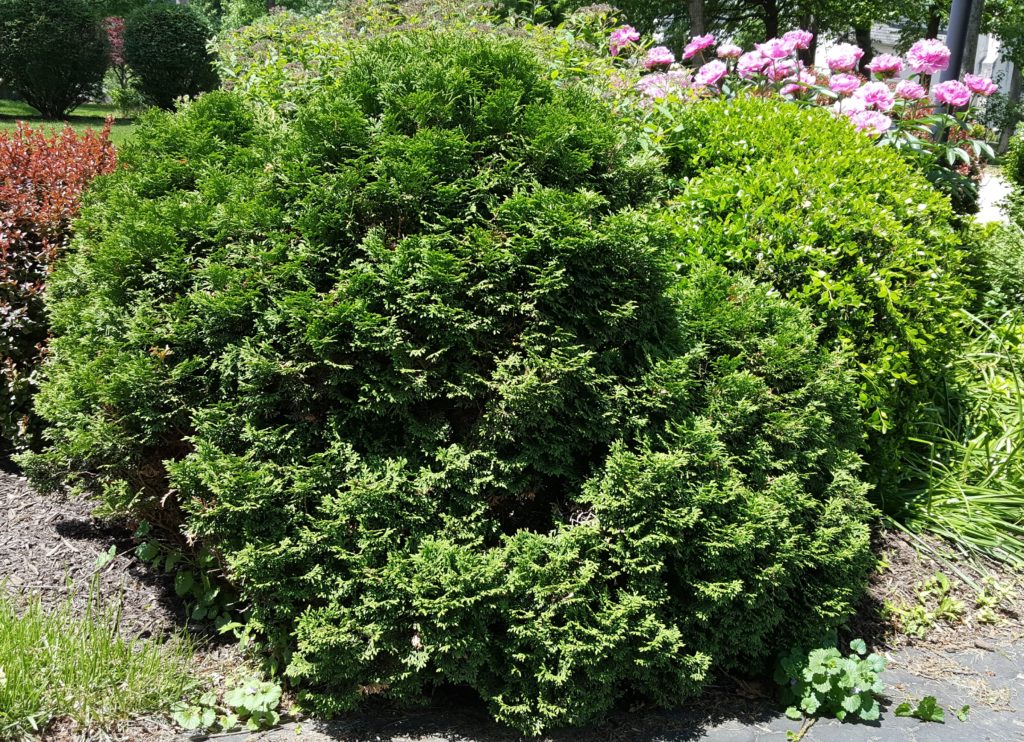
Thuja occidentalis (Dwarf American Arborvitae, Hetz Midget). Zones 3-8, full sun, 30 in. tall and wide. This dwarf evergreen shrub is a favorite in any landscape. It has dark-green fan-like leaves, and is totally care-free. Although it is not listed as deer-resistant, deer have not bothered this arborvitae and two others in my garden in many years. Perhaps it is not part of the local cuisine.
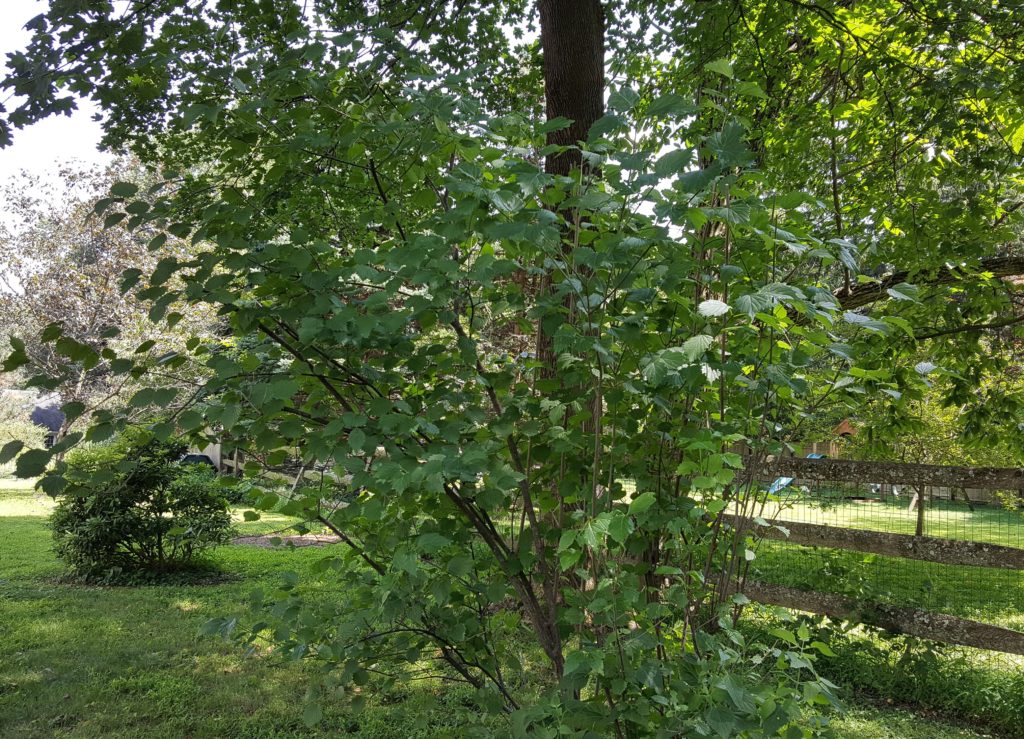
Viburnum dentatum “Blue Muffin” (Arrowwood dentatum). Zones 3-8, full sun to part shade, 3-5 ft tall and 3-4 ft wide. This upright multi-stemmed, deciduous shrub is native to Eastern North America. It has ovate, toothed dark-green leaves and white flowers in May to June. Fruits are blue-black berries, and are good for birds. It is tolerant to drought when established. Blue Muffin is the one most tolerant to shade among the family members. Deer never bother members of the viburnum family.
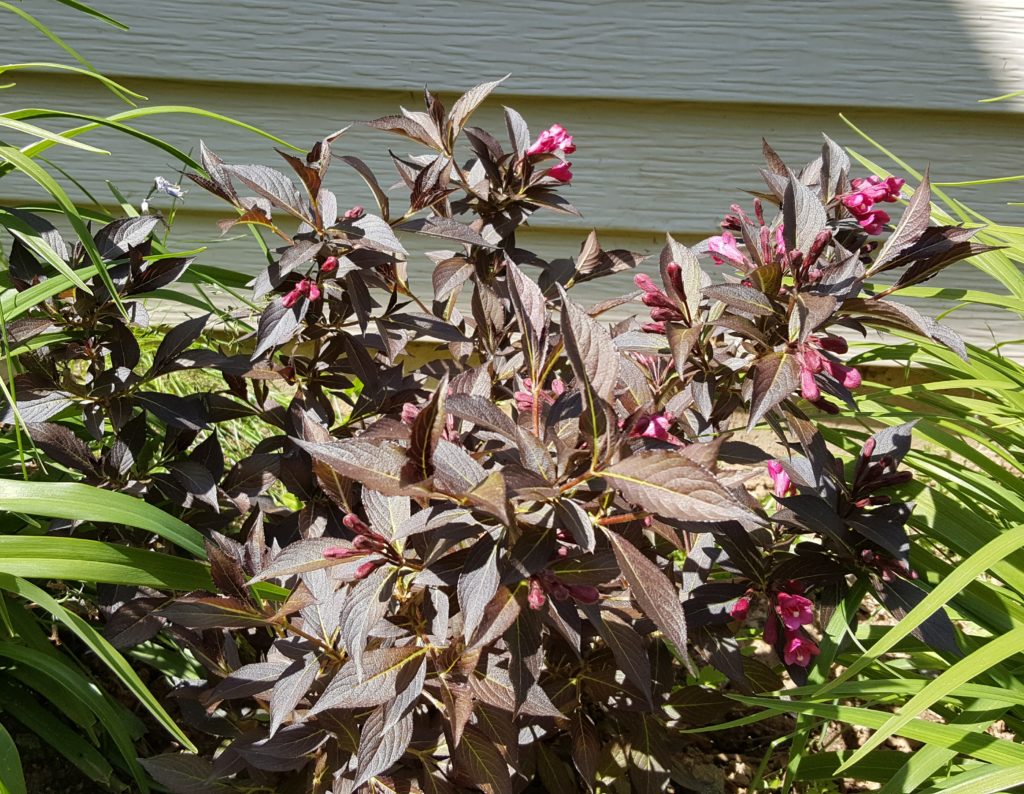
Weigela florida ‘Bokraspiwi’ (Spilled Wine Weigela). Zones 4-8, full sun, 18-24 inches tall and 3 ft wide. This beautiful deciduous shrub has dark purple-red foliage and blooms in late spring with magenta-pink flowers. Spilled Wine Weigela is an ideal shrub for a sunny side of the foundation. Furthermore, a taller (4-5 ft) cousin called Weigela Wine and Roses is also available. Deer do not bother them.
Use of these shrubs in deer resistant landscape designs
For some examples of deer resistant landscape designs, please go to this page.
